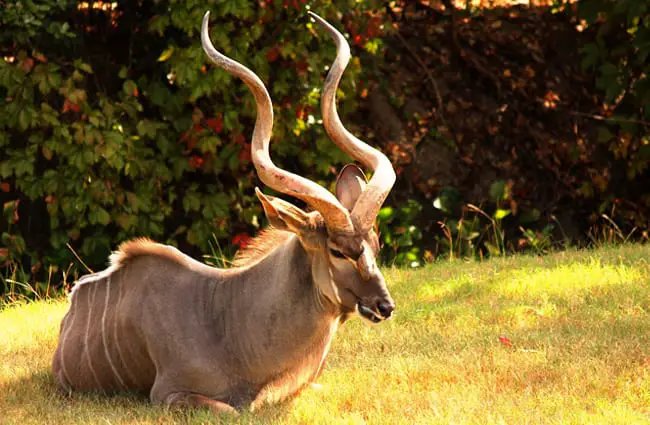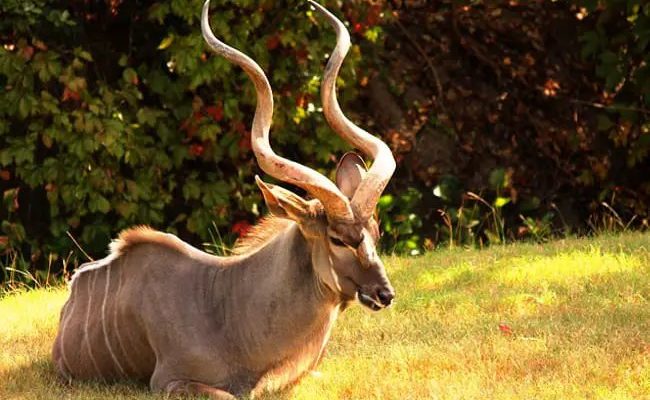
If you’re new to the world of kudus, don’t worry! You’re not alone. They live in the vast landscapes of sub-Saharan Africa, and while they might be shy creatures, their unique traits and behaviors are worth exploring. Today, I’m excited to share ten captivating facts about these remarkable animals. So, grab a cup of coffee, and let’s dive into the world of the kudu!
1. Two Distinct Species of Kudu
There are two main types of kudus: the greater kudu and the lesser kudu. The greater kudu is the larger of the two, standing up to 4.5 feet tall at the shoulder and weighing up to 600 pounds! Isn’t that impressive? Their long, spiral horns can reach lengths of nearly 6 feet in males. On the other hand, the lesser kudu is a bit smaller, standing around 3.5 feet tall and weighing between 90 and 120 pounds.
Both species are distinct in their appearance, with the greater kudu showcasing a more pronounced stripe pattern on their coats. The lesser kudu, meanwhile, has a softer, more muted color palette that helps them hide in the dense bush. Think of it like the difference between a tall, booming voice and a soft whisper—each has its own presence in the wild.
2. The Kudu’s Incredible Adaptability
Kudus are incredibly adaptable animals, thriving in various habitats, including savannas, woodlands, and even mountainous regions. Their ability to adjust to different environments is pretty remarkable. They rely on their keen senses to detect predators, which helps them stay safe in the wild.
What’s more, kudus are browsers rather than grazers. This means they prefer to eat leaves, shrubs, and other high-growing plants. They can stretch their long necks to reach food that many other animals can’t. So, while a zebra might munch on the grass below, a kudu is happily snacking on the greenery above. Nature has its way of ensuring each species finds its niche!
3. Unique Social Structures
Kudus don’t live in large herds like some other animals do. Instead, they often form small groups, usually consisting of females and their young. Males tend to be more solitary, especially as they reach maturity. It’s like a family reunion where the kids stick close to their parents while the older siblings venture out on their own.
Female kudus are nurturing and protective, teaching their young essential survival skills. You might wonder how they communicate in such small groups. They use a variety of sounds—like soft whistles or grunts—to stay in touch with one another, especially when danger is near.
4. Stunning Physical Features
One of the most striking things about kudus is their physical appearance. Their large, curious eyes and elongated ears give them a unique and expressive look. Those ears can rotate almost 180 degrees! So, if you think of them like satellite dishes, they can tune into sounds from all directions, helping them stay alert to predators.
And let’s not forget their coat! Kudus have a beautiful gray-brown color that allows them to blend seamlessly into their surroundings. The bold white stripes running down their bodies not only enhance their looks but also help with camouflage. When a kudu stands still amongst the trees, it can be surprisingly hard to spot—nature’s own hide-and-seek champion!
5. The Kudu’s Diet
Kudus are herbivores, which means they munch on a variety of plants. Their diet mainly consists of leaves, fruits, and flowers. They have a strong preference for certain types of trees, especially acacias and shrubs. What’s fascinating is how their specialized teeth help them browse efficiently.
These animals are known for their selective eating habits. They often choose the most nutritious parts of the plants, which is one reason they thrive in the wild. Plus, their grazing habits help promote healthy plant growth, ensuring a balanced ecosystem. Talk about being part of the cycle of life!
6. Remarkable Jumping Ability
Kudus are famous for their impressive jumping skills. They can leap as high as 8 feet in the air and cover distances of up to 30 feet in a single bound! That’s like watching an Olympic athlete in action. This ability helps them navigate through their rugged, bushy habitats and escape predators quickly.
Imagine a kudu bounding gracefully over a fallen tree or a rocky outcrop. It’s both a beautiful sight and a vital survival skill. Their long legs and powerful muscles give them the agility they need to thrive in the wild.
7. The Role of the Kudu in African Culture
Kudus hold a special place in various African cultures. In many communities, they symbolize grace and strength and are often featured in traditional stories and art. Their horns are also highly valued—some cultures use them to make ceremonial items or even musical instruments.
You might even find kudu motifs adorning fabrics and crafts, celebrating their beauty and importance. This connection to human culture highlights the respect that many people have for these magnificent animals. You could say kudus inspire a sense of wonder that extends beyond the animal kingdom.
8. Conservation Status and Challenges
Despite their beauty and resilience, kudus face threats in the wild. Habitat loss due to agriculture and human encroachment is a significant challenge. Additionally, hunting and poaching have reduced their populations in some areas. Efforts are underway to protect these animals and their habitats, but there’s still a long way to go.
Conservation programs focus on educating local communities about the importance of preserving wildlife, including kudus. It’s a team effort that highlights how humans can work together to protect these animals for future generations.
9. Kudu Behavior and Lifestyle
Kudus are primarily crepuscular, meaning they’re most active during dawn and dusk. This behavior allows them to avoid the heat of the day and reduce the risk of encountering predators. Picture them stretching and grazing as the sun sets, the world bathed in a golden glow.
Interestingly, kudus have a unique way of signaling danger to each other. When one senses a threat, it often freezes and stands still, alerting the others to the potential danger. It’s like they have their special code of conduct—an instinctive teamwork that enhances their survival.
10. Fun Facts to Wrap Up
Kudos to the kudu for being such an incredible animal! Here are a few fun facts to wrap things up:
- Kudus can go for long periods without water, getting moisture mostly from the plants they eat.
- They have a unique “huff” sound that they make when they’re startled or frightened.
- The female kudu is often more social than the male, forming tight-knit family groups.
- Young kudus are born with spots that fade as they grow older, helping them blend in with their surroundings.
Isn’t it amazing how much there is to learn about these graceful creatures?
As you can see, kudus are not only visually stunning but also play vital roles in their ecosystems. From their incredible adaptability to their unique social behaviors, there’s a lot to appreciate about these antelopes. So, next time you think about wildlife, remember the kudu and all they have to offer the world.

